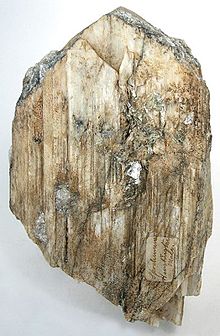Our website is made possible by displaying online advertisements to our visitors.
Please consider supporting us by disabling your ad blocker.
Spodumene
| Spodumene | |
|---|---|
 Walnut Hill Pegmatite Prospect, Huntington, Hampshire County, Massachusetts, U.S. (size: 14.2 × 9.2 × 3.0 cm) | |
| General | |
| Category | Inosilicate |
| Formula (repeating unit) | lithium aluminium silicate, LiAl(SiO3)2 |
| IMA symbol | Spd[1] |
| Strunz classification | 9.DA.30 |
| Dana classification | 65.1.4.1 |
| Crystal system | Monoclinic |
| Crystal class | Prismatic (2/m) (same H-M symbol) |
| Space group | C2/c |
| Unit cell | a = 9.46 Å, b = 8.39 Å c = 5.22 Å β = 110.17°; Z = 4 |
| Identification | |
| Color | Highly variable: white, colorless, gray, pink, lilac, violet, yellow and green, may be bicolored; emerald green – hiddenite; lilac – kunzite; yellow – triphane |
| Crystal habit | prismatic, generally flattened and elongated, striated parallel to {100}, commonly massive |
| Twinning | Common on {100} |
| Cleavage | Perfect prismatic, two directions {110} ∧ {110} at 87° |
| Fracture | Uneven to subconchoidal |
| Tenacity | Brittle |
| Mohs scale hardness | 6.5–7 |
| Luster | Vitreous, pearly on cleavage |
| Streak | white |
| Specific gravity | 3.03–3.23 |
| Optical properties | Biaxial (+) |
| Refractive index | nα = 1.648–1.661 nβ = 1.655–1.670 nγ = 1.662–1.679 |
| Birefringence | δ = 0.014–0.018 |
| Pleochroism | Strong in kunzite: α-purple, γ-colorless; hiddenite: α-green, γ-colorless |
| 2V angle | 54° to 69° |
| Fusibility | 3.5 |
| Solubility | insoluble |
| Other characteristics | Tenebrescence, chatoyancy |
| References | [2][3][4][5] |
Spodumene is a pyroxene mineral consisting of lithium aluminium inosilicate, LiAl(SiO3)2, and is a commercially important source of lithium. It occurs as colorless to yellowish, purplish, or lilac kunzite (see below), yellowish-green or emerald-green hiddenite, prismatic crystals, often of great size. Single crystals of 14.3 m (47 ft) in size are reported from the Black Hills of South Dakota, United States.[6][7]
The naturally-occurring low-temperature form α-spodumene is in the monoclinic system, and the high-temperature β-spodumene crystallizes in the tetragonal system. α-spodumene converts to β-spodumene at temperatures above 900 °C.[5] Crystals are typically heavily striated parallel to the principal axis. Crystal faces are often etched and pitted with triangular markings.[not verified in body]
- ^ Warr, L.N. (2021). "IMA–CNMNC approved mineral symbols". Mineralogical Magazine. 85 (3): 291–320. Bibcode:2021MinM...85..291W. doi:10.1180/mgm.2021.43. S2CID 235729616.
- ^ Spodumene, Mindat.org
- ^ Anthony, John W., Bideaux, Richard A., Bladh, Kenneth W., and Nichols, Monte C. (1990). Handbook of Mineralogy. Mineral Data Publishing, Tucson, Arizona
- ^ Hurlbut, Cornelius S.; Klein, Cornelis, 1985, Manual of Mineralogy, 20th ed., ISBN 0-471-80580-7
- ^ a b Deer, Howie and Zussman, Rock Forming Minerals, v. 2 Chain Silicates, Wiley, 1963 pp. 92–98
- ^ Schwartz, G. (1928). "The Black Hills Mineral Region". American Mineralogist. 13: 56–63.
- ^ Robert Louis Bonewitz, 2005, Rock and Gem, London, Dorling Kindersley
Previous Page Next Page


